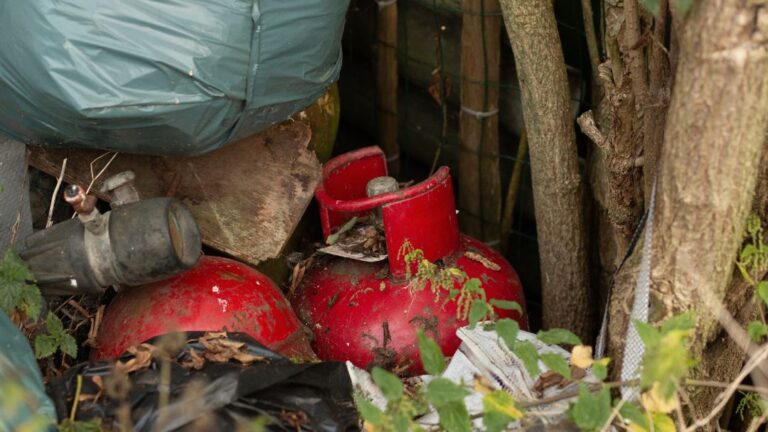Complying with Standards Using Hazardous Material Storage Containers: A Quick Guide
- Jonathan R.
- August 7, 2024
Table of Contents
Handling hazardous materials isn’t just about getting the job done; it’s about doing it safely and responsibly. And a huge part of that responsibility lies in how we store these materials. That’s where hazardous material storage containers come into play. These specialized containers are key to preventing accidents and ensuring compliance with strict regulations. Next, we’ll dive into what you need to know to keep everything safe and sound. Let’s begin.
Understanding Hazardous Materials and Their Risks
Hazardous materials can be a bit like a box of chocolates; you never quite know what you’re going to get. They can be flammable, corrosive, toxic, or reactive, and storing them improperly can lead to serious trouble. The first step in handling them safely is understanding these risks.
Using the proper hazardous material storage containers can make all the difference. These containers are designed to keep dangerous substances secure and prevent leaks, spills, and contamination. Think of them as the first line of defense in your safety arsenal.
Each type of hazardous material requires a specific storage solution. Knowing what you’re dealing with helps in choosing the right container, which is crucial for ensuring safety and compliance with regulations.
Key Regulations Governing Hazardous Material Storage
Regulations can feel like a maze, but they’re there for a good reason: keeping everyone safe. The Occupational Safety and Health Administration (OSHA) and the Environmental Protection Agency (EPA) set the standards for how hazardous materials should be stored.
OSHA focuses on workplace safety. They have strict rules about building, labeling, and ventilating storage containers. For example, flammable liquids must be stored in containers that prevent ignition.
The EPA’s guidelines aim to protect the environment. They ensure that storage containers are designed to prevent leaks that could contaminate soil and water. Their regulations cover everything from the materials used in containers to their maintenance.
Following these regulations is not just about avoiding fines; it’s about creating a safe working environment and protecting the planet. Understanding these rules is essential for anyone dealing with hazardous materials.
Choosing the Right Hazardous Material Storage Containers
Picking the proper storage containers can feel overwhelming with all the options out there. But getting it right is crucial. Here are some key factors to consider when selecting hazardous material storage containers:
- Material compatibility. Ensure the container material is suitable for the substance you’re storing (e.g., flammable liquids or corrosive acids).
- Size and capacity. Choose containers that fit the volume of material without being too large to handle.
- Design features. Look for secure, airtight seals and secondary containment systems to prevent leaks.
- Regulatory compliance. Ensure containers meet OSHA, EPA, and other regulatory standards.
- Durability and quality. Invest in high-quality, durable containers that can withstand your storage conditions.
- Ease of use. Select containers that are easy to handle, transport, and maintain.
By considering these factors, you can ensure that you choose the right hazardous material storage containers to keep your workplace safe and compliant.
Best Practices for Safe Handling and Storage
Having suitable containers is just part of the equation. You also need to follow best practices for handling and storage to ensure maximum safety. Here are some essential tips to keep in mind:
- Employee training. Ensure all employees understand the risks associated with hazardous materials and know how to use storage containers correctly. Proper training is the foundation of the safe management of dangerous material.
- Regular inspections and maintenance. Schedule routine checks of your storage containers to look for signs of wear, damage, or leaks. Address any issues promptly to prevent accidents and stay compliant with regulations.
- Clear labeling. Each container should be clearly labeled with the type of material, hazard warnings, and handling instructions. This helps prevent mishandling and ensures everyone knows what they’re dealing with.
- Detailed documentation. Keep comprehensive records of all hazardous materials, including quantities, locations, and storage conditions. This makes management easier and ensures you’re always prepared for inspections.
- Secondary containment systems. Use secondary containment measures to add an extra layer of protection against spills and leaks. This can be especially important for highly hazardous or large quantities of materials.
- Proper ventilation. Ensure that storage areas are well-ventilated to prevent the build-up of fumes, which can be dangerous. Ventilation is key to maintaining a safe environment around hazardous materials.
Following these best practices can create a safer workplace and ensure compliance with all relevant regulations.
The Role of Safety Storage Inc. in Hazardous Material Management
At Safety Storage Inc., we get it; handling hazardous materials can be challenging. That’s why we’ve spent over 35 years perfecting our hazardous material storage containers. We offer customizable, prefabricated solutions that meet all regulatory requirements and exceed safety standards.
Our containers are designed to handle a variety of hazardous materials, whether you’re in government, municipal, or manufacturing sectors. Each product is built to withstand the specific risks of different materials, ensuring top-notch protection and peace of mind.
We’re not just about selling products; we’re about building partnerships. Your safety and satisfaction are our top priorities. Whether you need a standard solution or a custom-built container, Safety Storage Inc. has you covered.
Conclusion
Managing hazardous materials isn’t just about following rules but creating a safe and responsible environment. Hazardous material storage containers are a crucial part of this effort. By understanding the risks, adhering to regulations, choosing the right containers, and following best practices, you can ensure a safe and compliant workspace.
At Safety Storage Inc., we’re here to help. Our expertise and high-quality storage solutions are designed to meet your needs and keep you safe. Contact us today to learn more about how we can support your hazardous material storage requirements.
Read More:
Hazmat Storage Containers

Jonathan Reed
Jonathan Reed specializes in writing in-depth, data-driven content on industrial waste management, regulatory compliance, and environmental sustainability. With expertise in hazardous waste disposal, OSHA guidelines, and waste reduction technologies, he provides actionable insights for businesses navigating complex waste management challenges.



